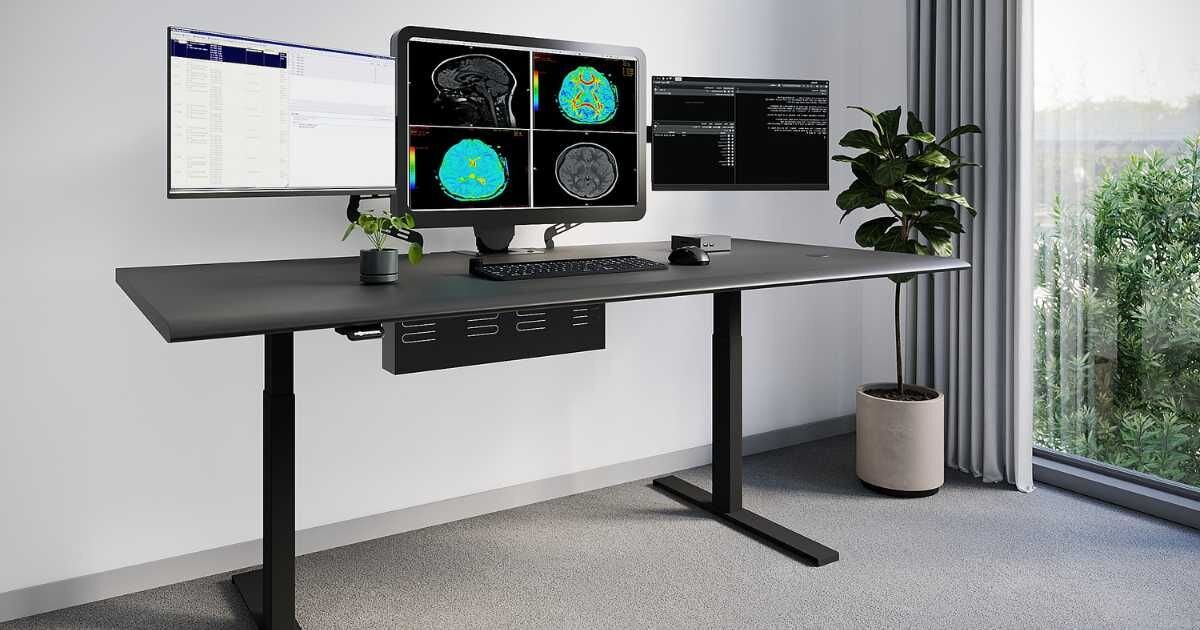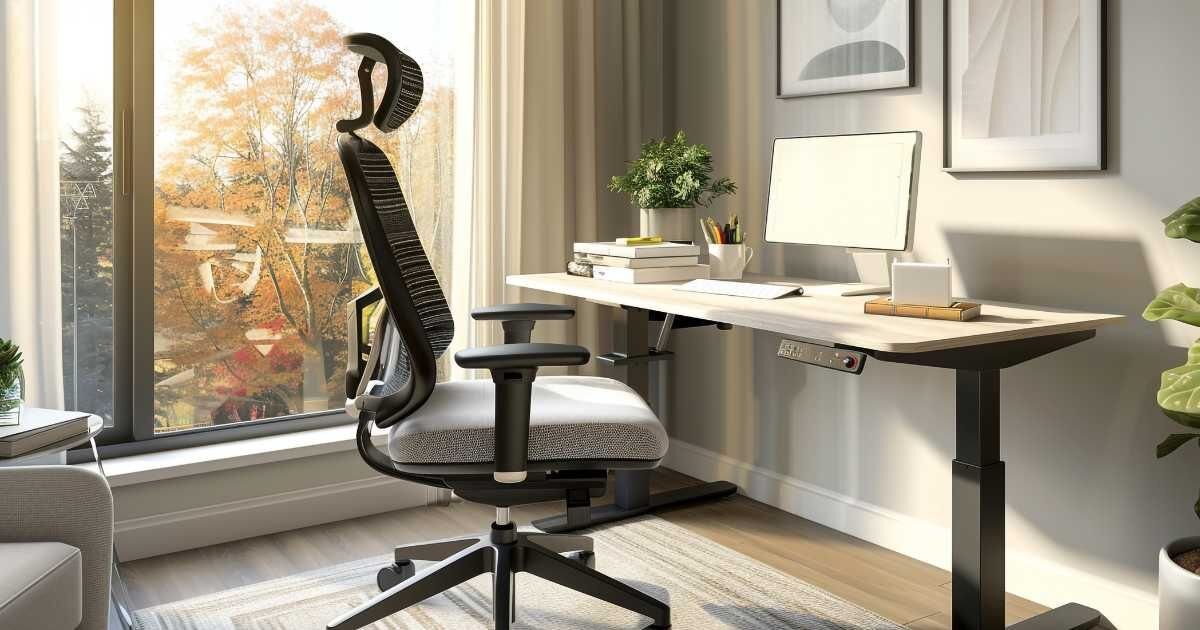
We collect basic website visitor information on this website and store it in cookies. We also utilize Google Analytics to track page view information to assist us in improving our website.

The shift to remote work has transformed many professions, including radiology. With advancements in teleradiology and Picture Archiving and Communication Systems (PACS), radiologists can now review medical images from the comfort of their homes. This transition, accelerated by the COVID-19 pandemic, has allowed radiologists to work remotely while maintaining productivity.
However, long hours spent analyzing images on multiple screens at home present new challenges, especially regarding physical health.
Proper ergonomics setups are essential to prevent repetitive strain injuries (RSIs) and assure that all radiologists can work comfortably and efficiently. RedRick Technologies offers personalized ergonomics designs so radiologists can optimize their home workspace healthily and productively.
Teleradiology, the practice of delivering radiology services remotely (without being physically present at a healthcare facility), is an increasingly prevalent and innovative approach in modern healthcare.
Although radiologists have been working from home since the 1990s, more radiology departments rapidly adopted home workstations to comply with safety and social distancing measures, primarily due to being in the healthcare sector during the COVID-19 pandemic. A survey of 174 radiologists revealed that 73.6% of sites installed home workstations, and 55.9% of respondents plan to continue remote work even post-pandemic due to its benefits.
Decreased Stress: Working from home often leads to a more relaxed environment, reducing the mental and physical stress associated with long commutes and hectic hospital settings.
Improved Work-Life Balance: Remote work allows radiologists to balance their professional duties with personal responsibilities, improving overall well-being.
Consistent Productivity: Many radiologists report that their productivity remains high while working remotely. Some even note faster turnaround times for diagnostic reports.
While teleradiology has benefits, many radiologists were unprepared to recreate the ergonomic setups they previously had in hospital reading rooms. The result was a host of physical discomforts, including:
Musculoskeletal Disorders (MSDs): Prolonged hours of sitting in makeshift home offices, such as dining room tables or chair recliners, can lead to MSDs affecting the muscles, nerves, and tendons.
Eye Strain: Inadequate lighting and improper monitor placement can increase the risk of Computer Vision Syndrome (CVS), which can cause headaches, dry eyes, and visual fatigue.
Addressing these ergonomic challenges is essential for radiologists working from home. RedRick Technologies is leading the way in providing solutions tailored to radiologists' needs in their specific home environments.
Without the specialized setups typically found in hospital reading rooms, home offices are often less equipped to support the long hours radiologists spend in sedentary positions, leading to physical discomfort and health issues.
Radiologists are especially vulnerable to repetitive strain injuries (RSIs) and musculoskeletal disorders (MSDs) due to the prolonged periods spent working on diagnostic images, using a keyboard and mouse, and viewing multiple monitors. These injuries are among the most commonly reported workplace strains. In a non-optimized home office setting, common causes include:
Poor Seating: Without ergonomic chairs, radiologists may experience back, neck, and shoulder strain from poor posture.
Improper Monitor Placement: Monitors positioned too high or low can lead to neck pain, while improper focal distance can contribute to eye strain.
Static Positions: Sitting for extended hours without frequent changes in position can contribute to fatigue and discomfort, particularly in the lower back and legs.
A study by Dr. Talia Vertinsky found that 65.4% of radiologists experience Computer Vision Syndrome (CVS) symptoms. This condition, caused by prolonged screen exposure, leads to a variety of eye-related issues such as:
Headaches
Dry Eyes
Blurred Vision
Neck and Shoulder Pain
Inadequate Lighting: Poor ambient lighting and excessive screen glare can cause visual fatigue.
Improper Screen Setup: Monitors that are too bright, too far away, or poorly positioned can exacerbate eye strain and fatigue.
Remote radiologists must address these ergonomic challenges to avoid long-term health issues. RedRick Technologies offers customized solutions to create home workspaces that reduce strain, improve comfort, and enhance productivity, allowing radiologists to work efficiently without compromising their well-being.
Creating an ergonomic workstation is essential for radiologists working from home to maintain long-term comfort, health, and efficiency. A few key components are critical in optimizing a home office for radiologists, who spend extended hours at their desks reviewing medical images.
Height-adjustable desks, also known as sit-stand desks, allow radiologists to alternate between sitting and standing throughout the day. This simple adjustment helps alleviate the physical strain associated with prolonged sitting and reduces the risk of repetitive strain injuries (RSIs).
Benefits: Research by the American Medical Informatics Association found that using sit-stand desks increased radiologists' productivity by 12% and reduced musculoskeletal pain by 10%.
Improved Circulation: Rotating in intervals between 15-30 minutes of sitting and standing can promote better circulation and prevent stiffness and fatigue in the lower back and legs.
Improper monitor placement can result in significant cervical issues, and eye strain or discomfort, especially for radiologists who often work with multiple screens.
Eye-Level Positioning: Monitors should be placed at eye level, about 50-75 cm from the user’s eyes, to maintain a neutral neck position and reduce eye-strain.
Minimize Glare: Monitors should be positioned to avoid direct light and screen glare, which can lead to eye strain and impact diagnostic accuracy.
Regular computer chairs do not provide the support a well-designed ergonomic chair can. Ergonomic chairs are designed to support proper posture and prevent back pain.
Lumbar Support: Chairs with adjustable lumbar support help maintain the spine's natural curve, reducing strain on the lower back.
Customizable Fit: Adjustable features like seat heights, armrests, and tilt encourage a neutral and comfortable sitting position for radiologists.

Regular overhead lighting in a home can often be too bright and distracting, leading to increased eye strain and distraction. Proper light can enhance visual clarity while working.
Ambient and Task Lighting: Incorporating dimmable ambient lighting and focused task lighting minimizes glare and reduces the risk of eye strain, creating a more comfortable viewing environment.
Incorporating these key ergonomic elements helps radiologists create a home office that promotes both health and productivity. RedRick Technologies provides ergonomic solutions such as sit-stand desks, monitor mounts, and specialized lighting, all personalized to the needs of remote radiologists.

Beyond creating ergonomic solutions for radiologists in medical settings, we have branched out and created ErgoHome Workstations. Our specialization in ergonomic designs has led us to develop a range of products and solutions that improve the comfort and efficiency in home offices:
ComfortView Monitor Mount: Provides 12 inches of motorized height adjustment, allowing radiologists to reposition their monitors easily. It also includes effortless focal depth adjustment, supporting large, high-resolution monitors over 30 inches and ensuring accessible dual-display configurations.
ErgoHome-LITE series: It offers several vital ergonomic features designed for radiologists. The height-adjustable work surface includes motorized adjustment from 24” to 49.5”, operated with a touch control, and can lift up to 350 lbs. It also features a high-pressure laminate top with an ergonomically contoured front edge for added comfort, with 36” D x 72” W standard dimensions.
Ambient Lighting: The workstation includes dimmable ambient backlighting, adjustable between 465nm blue and 5k white, to reduce eye strain and visual fatigue during long reading sessions. This combination of features helps radiologists work comfortably and efficiently throughout the day.
RedRick’s ErgoHome-LITE solutions give radiologists the tools to create a home workspace that adapts to their needs, providing both comfort and functionality for long hours of remote work.
In combination with ergonomic workstations, radiologists can maintain ergonomic health while working from home by incorporating these practical exercises and making minor adjustments. These tips can significantly improve comfort and productivity throughout the workday:
Take Regular Breaks: Schedule short breaks every 30-60 minutes to stretch, stand, or walk. This helps prevent stiffness and reduces the risk of repetitive strain injuries.
Stretching: Incorporate stretches that target the wrists, shoulders, neck, and back to improve flexibility and reduce muscle tension.
Posture: Maintain proper posture by keeping your back straight, feet flat on the floor, and elbows close to your body.
To reduce eye strain and fatigue:
Lighting Placement: Use dimmable lighting, ideally located behind the monitor set and illuminating the wall behind the monitors, to prevent glare and enhance comfort.
Lighting Brightness: Set the ambient light level to a comfortable level that complements the monitor’s level of brightness.
Monitor Position: To minimize neck strain, place your monitor at eye level and at least 50-75 cm from your eyes.
Home office ergonomics are essential for remote radiologists' ability to maintain overall comfort, productivity, and long-term health. Our ergonomic workstations are specially designed to enhance daily performance and reduce the risk of injuries such as musculoskeletal disorders and eye strain. Discover how RedRick Technologies' ergonomic solutions can help you create a healthier, more efficient remote workspace.
Contact us today to learn more about transforming your home office with personalized ergonomic solutions.

Radiology is a highly regulated environment that deals with the facts of the medical world – there isn’t much “guesswork” involved, per se. Rather, the industry is comprised of professionals specially trained to identify the source of a patient’s problem.
Yet, there are still some major misconceptions about ergonomics and how it applies to radiology. From fads to facts, the experts at RedRick Technology will take you through radiology’s biggest ergonomic myths.
The common consensus to the point of being an ergonomic fad is the idea that tilting surfaces are the epitome of good posture. The idea is that, while sitting upright, your arms should be bent at 90-degrees and your desk should be set at the height of your forearms. Then, you’re able to tilt your desktop to accommodate an optimal position.
While this is a widespread recommendation, there are many things this ergonomic myth doesn’t consider. First, perhaps the most obvious consideration is that good ergonomics doesn’t mean sitting in a single position; truly GOOD ergonomics allows you to adjust your position to avoid discomfort and injury.
For example, if your monitors can be tilted independently, then the need for an entirely tiltable desktop doesn’t add much. Your elbows don’t need to be at 90-degrees if the user is leaning back in their chair, looking up at a monitor.
Perhaps the worst offender of all of radiology’s biggest ergonomic myths is that there is a “best position” to avoid pain and discomfort – back pain in particular. Many of us, even as kids, were taunted by our parents and teachers with the idea that if we didn’t sit with our backs straight, we would develop “hunch backs.”
This is not only untrue, but it carries into radiology. Luckily, we have the power of research on our side.
According to the Journal of Orthopaedic & Sports Physical Therapy, there's not just a lack of data linking poor posture to back pain, but for some, sitting in an upright, rigid position triggered back pain and tightness. The study concluded that there isn't a singular "correct" posture. Rather, you should use positions that feel right to you with more relaxed postures.
In fact, the more you move around each day, regardless of posture, the less stiff and achy you tend to feel. Physical activity is usually in the first lineup of recommendations for people suffering from musculoskeletal pain.
This is why having adjustable ergonomic workstations is an essential part of maintaining workplace productivity and physical health. Being able to change positions to fit your physical needs can help reduce pain and injury. This is tenfold if you’re able to stand and add exercise. Ergonomic adjustment and exercise are shown to aid in musculoskeletal discomfort, according to the National Library of Medicine.
So, no, you don’t need to wear a back brace to work to force yourself into an upright position. Rather, you can have an adjustable ergonomic workstation to allow you freedom of movement.

Listen, everyone has the right to design their ergonomic workspace how they feel they need. However, it’s a myth that it is REQUIRED that a good ergonomic workstation have a keyboard tray.
While there are a variety of times where a keyboard tray could be helpful or necessary, if you’re considering ergonomics in the initial design of your workstation, it’s usually not required. If your station has adjustable chairs, work surfaces, and independent monitor mounts, you really don’t need a keyboard tray.
These elements already make your ergonomics optimal. If you want a keyboard tray, that’s fine, but it isn’t required to have an ideal ergonomic setup.
Um… no, not quite. Radiologists need to avoid monitor glare so that they don’t experience eye strain, but that doesn’t mean they have to work in the dark. In fact, it’s more advisable to work in a room that offers ambient lighting – which avoids monitor glare while providing extra benefits. These include reducing eye fatigue and headaches.
A 2022 study explored the prevalence of Computer Vision Syndrome (CVS) in radiologists and radiology residents and found that CVS is an increasing concern.
According to the American Optometric Association (AOA), CVS encompasses a range of eye- and vision-related issues caused by prolonged use of computers, tablets, e-readers, and smartphones. The most frequent symptoms include eyestrain, headaches, blurred vision, dry eyes, and neck and shoulder discomfort.
This study found that an astonishing 65.4% of the 416 radiologists and residents surveyed reported experiencing CVS, highlighting the significant impact this condition can have on professionals who rely heavily on digital technology.
However, ambient lighting is shown to alleviate elements of eyestrain and associated health struggles.
The consensus is that people who regularly use a computer (especially for work) are at an increased risk of musculoskeletal injury due to repetitive stress.
The role that ergonomics plays in the radiology sphere is to make sure that working conditions are carefully crafted to avoid ongoing fatigue or injury. By optimizing ergonomics, you can also increase workplace productivity, health, efficiency, and even happiness within the job.
Now that we’ve busted some of radiology’s biggest ergonomic myths, it’s time to review the facts.
It’s no shock to know that radiologists are often working long shifts at their workstations, which can lead to strain on the neck, back, and shoulders. However, ergonomic workstations are specifically designed to reduce musculoskeletal stress by promoting movable posture, minimizing repetitive movements, and reducing strain on the spine.
Radiologists spend a lot of their time expertly reviewing detailed images, which can cause eye strain. Optimized ergonomic workstations can help adjust monitor height, angle, and distance, improving visibility and reducing eye strain. This subsequently lowers the risk of developing Computer Vision Syndrome (CVS).
Comfortable working conditions have been proven to reduce fatigue and discomfort, which can allow radiologists to improve their overall accuracy and work performance. Being comfortable and having low fatigue can also improve job satisfaction, resulting in a lower turnover rate.
Radiologists often report chronic neck and back pain due to long hours and workstations that haven’t been optimized for ideal ergonomics. Proper ergonomic setups reduce these risks by aligning the body in a neutral posture and allowing movement, preventing long-term health issues.
Ergonomics contributes to smoother workflow by allowing for customizable setups (i.e., adjustable desks and chairs, multi-monitor systems) that enhance accessibility and reduce wasted motion during work.
Reduced physical strain can help prevent burnout in radiologists, who are at high risk due to the demanding nature of their work. According to the National Institute of Health, a study showed that 54-72% of diagnostic and interventional radiologists had symptoms of burnout. Preventing this can improve their work life and enable them to focus better on providing the best possible patient care.
RedRick Technologies has spent more than two decades operating in the radiology sector, learning more and expanding our knowledge to best optimize radiology reading rooms. Our knowledge has expanded over 20 years and has enabled us to create the most modern products that don't fall into a one-size model.
These products are intricately designed and customized to our client's unique needs, which supports the critical need for high-quality patient care. The work of radiologists is essential, and they deserve the best, most quality ergonomic workstation to allow them to do their job to the best of their ability.
Ergonomic workstations should never be an afterthought – they should be at the front of the mind. They're not only capable of improving the health and well-being of radiologists, but they are essential tools in the diagnostic and healthcare industry. They need to be designed with this concept in mind.

Just as a surgeon needs an optimized operating room, so too do radiologists need ergonomic solutions and thoughtfully designed workstations. The RedRick Technology approach focuses on flexibility and customization. Every situation we enter is unique, and so are our designs. Our mission is to create workstations that fit perfectly into your workspace.
What's most important is that our workstations are easy to use and provide a great range of customization and movement, even in some of the most complex environments.
Our workstations are engineered to support heavy-duty professional computer equipment and come with the assurance of a 10-year warranty.
Proudly designed and manufactured in North America, over 90% of our materials are sourced from the US and Canada, reflecting our dedication to quality and local resources.
Don’t leave it to chance – radiologists deserve to have the best of modern ergonomic workstations. Contact us today to receive a demo.